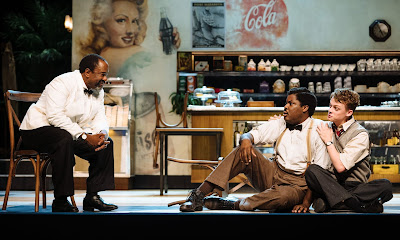It is difficult to imagine a more
dramatic, subtle and brilliant portrayal of South African racial relations than
Athol Fugard’s ‘Master Harold’…and the boys. Master Harold is a
white boy, barely in his teens. The “boys” are grown men who work in his
mother’s tea room. The title alone tells a great deal. But there is much more
in this delicate play that is getting a flawless production in the Lyttleton
stage of the National Theatre, in London.
There are three characters in the
play and the entire action takes place in the tea room over one hour and forty
minutes. Aristotle’s unities of time, place and action are adhered to.
The importance and brilliance of
the play lie in the fact that it is not about mistreatment of blacks by whites.
It presents a portrait of two black servants, Sam (Lucian Msamati) and Willie
(Hammed Animashaun), who have been friends, companions, educators and saviors
of the young white boy Hally (Anson Boon). Fugard wants to show that racism not
only exists (everyone knows that) but that it is so deeply rooted as to be almost
ineradicable.
Hally comes from an unhappy
family. His mother is domineering and his father a weakling who is ill. He does
not like his parents and has found solace and companionship with Sam and
Willie. But his parents are also racist to the core and have taught their son,
however subtly and perniciously, to be a racist as well.
Hally is a callow boy who does
not do well in school. As a child in boarding school, he used to escape from
his parents by hiding under Sam’s bed. Hally and Sam have prime memories of
pleasant events including Sam’s construction of a kite for Hally that sent him
flying higher than the kite itself. There is love and friendship between them.
But we see the cracks in the
relationship. Hally cannot accept the fact that the two tearoom workers are
involved in artistic activities - ballroom dancing. He looks down on them even
though Sam is probably smarter than him
Sam has a very high quotient of
decency and understanding and he tries to prevent the rift from developing
between he son and his father.
The play moves from pleasant
memories to talk about social reform until its riveting climax when Hally spits
on Sam as if he were a dog. It is a startling and arresting theatrical moment that
takes your breath away. It should, because that
is the reality and the result of apartheid but nevertheless it still shocks.
I have spoken at length about the
play and in effect have given the highest praise to the three actors and
director Roy Alexander Weise who moved me and shocked me as if it were the first
time I was seeing the play. It was not.
Msamati’s Sam exudes
intelligence, humanity, decency and deep understanding of people. Animashaun’s
Willie is a dreamer, not that bright but also a wife beater. Fugard does not idealize
anyone. Boon’s Hally is an unhappy youngster who may have grown into a decent
human being had he not been injected with so much racist poison that it may
never get out of his soul.
The set by Rajha Shakiry consists
of the counter, chairs and tables of a tearoom that does the job splendidly.
A great night at the theatre.
‘Master Harold’….and the boys by Athol Fugard continues until December 17,
2019 at the Lyttleton Stage, National Theatre, South Bank, London, England. www.nationaltheatre.org.uk.
James Karas is the Senior Editor - Culture of The Greek Press


No comments:
Post a Comment